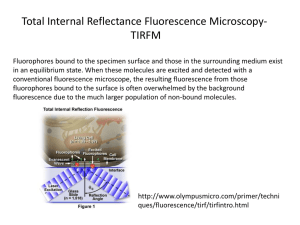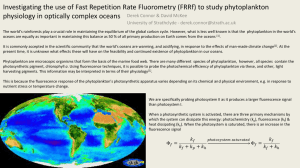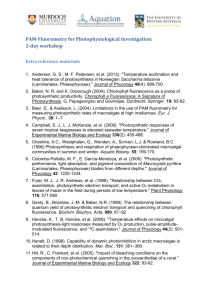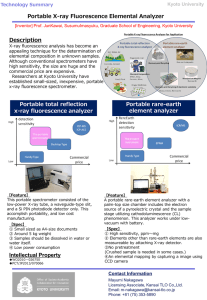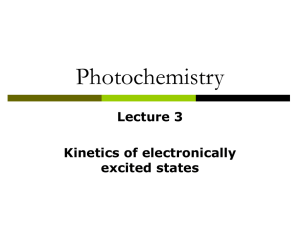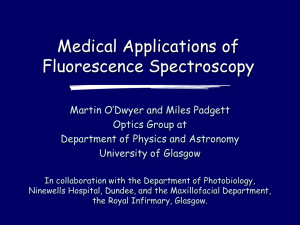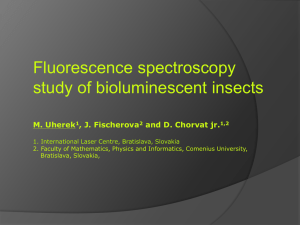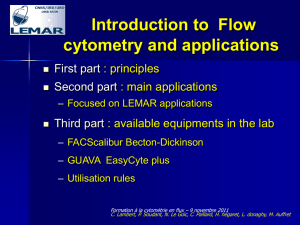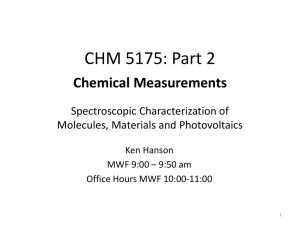Photosynthesis and Fluorescence
advertisement
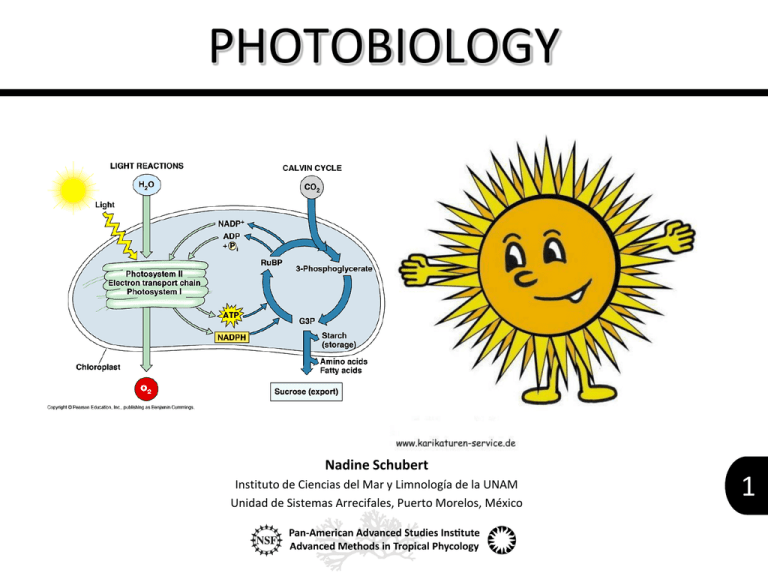
PHOTOBIOLOGY Nadine Schubert Instituto de Ciencias del Mar y Limnología de la UNAM Unidad de Sistemas Arrecifales, Puerto Morelos, México 1 WHAT DOES PHOTOBIOLOGY MEAN? Photosynthesis Photomorphogenesis Cirvadian Rhythm Ultraviolet Radiation 2 PHOTOBIOLOGY Part 1: Photosynthesis and Fluorescence Part 2: Photoacclimation/-adaptation Part 3: Photoprotection 3 Part 1: Photosynthesis and Fluorescence 4 PHOTOSYNTHESIS 5 LIGHT ABSORPTION 6 THE PHOTOSYNTHETIC APPARATUS 7 THE PHOTOSYNTHETIC APPARATUS ATPase LHCII PSII Cyt bf PSI LHCI 8 LIGHT ABSORPTION The absorbed light energy is funneled by excitation transfer into the RC’s, where energy Antenna Antenna pigments pigments conversion by charge separation takes place. PSPS II II Photochemistry Photochemistry 9 LIGHT ABSORPTION photon molecule absorbs photon ground state Increasing energy excited state 10 EXCITATION ENERGY TRANSFER Excitation transfer Electron transfer Acceptor Light e- Reaction Center eDonor Antenna 11 ELECTRON TRANSFER ATP ADP + Pi NADP + H+ 2H+ NADPH Fd ATPase PQH2 LHCII PSII Cyt bf PSI LHCI PQ 2H2O O2+ 4H+ PC 2H+ H+ 12 LIGHT ABSORPTION AND ENERGY TRANSFER 13 PHOTOSYNTHESIS AND FLUORESCENCE 14 PHOTOSYNTHESIS AND FLUORESCENCE photon excited state molecule absorbs photon excited state Photochemistry Fluorescence Heat ground state ground state 15 PHOTOSYNTHESIS AND FLUORESCENCE Antenna pigments Heat Fluorescence PS II Photochemistry 16 PHOTOSYNTHESIS AND FLUORESCENCE Antenna pigments Non-light -tress conditions Heat Fluorescence PS II Photochemistry 17 PHOTOSYNTHESIS AND FLUORESCENCE Photochemistry = 1 Fluorescence = 0 Photochemistry = 0 Fluorescence = 1 Whitmarsh & Govindjee (2002) 18 CHLOROPHYLL FLUORESCENCE MEASUREMENT PS = 0 NPQ = 0 Fv/Fm = (Fm-Fo)/Fm Fm = maximum fluorescence (RC’s closed) Fo = minimum fluorescence (RC’s open) PS = 1 NPQ = 0 (higher plants – 0.85, macroalgae usually lower) 19 Fv/Fm – MAXIMUM QUANTUM YIELD Quantum yield: Probability that the energy of a photon absorbed will be used for photosynthesis (i.e. enters in the e- - transport chain) Indicator of photosynthetic efficiency Maximum quantum yield: requires complete relaxation of the competing mechanisms with the photochemical energy conversion 20 Fv/Fm – Diurnal and spatial variation Depth (m) Chondrus crispus Macrocystis pyrifera Colombo-Pallotta (2007) Hanelt et al. (1992) 21 Fv/Fm – Comparison of stress responses between species Littoral Sublittoral Littoral Sublittoral Sublittoral Sublittoral van de Poll et al. (2001) 22 CHLOROPHYLL FLUORESCENCE MEASUREMENT Fv/Fm PS = 0 1 NPQ 0 F/Fm’ 1 PS 0 1 NPQ 0 23 F/Fm’ – EFFECTIVE QUANTUM YIELD Used to describe the variation in the photochemical efficiency of PSII under illuminated conditions. Measurement of this parameter at certain irradiance value. Indicator of the ability of an organism to move electrons beyond PSII (ETR) F/Fm’ = (Fm’-F)/Fm’ 24 ELECTRON-TRANSPORT RATE (ETR)– CURVES ETR = Irradiance F/Fm’ 0,5 Absorptance (Genty et al. 1989) F/Fm’ = effective quantum yield (under light) 0,5 = Assumption that 50% of these quanta are absorbed by PSII Absorptance = fraction of incident light that is absorbed by the photosynthetic tissue. Not the same as absorbance (quantifies how much of the incident light is absorbed by an object). 25 ELECTRON-TRANSPORT RATE (ETR)– CURVES ETR = Irradiance F/Fm’ 0,5 Absorptance Relative ETR = Irradiance F/Fm’ 0,5 (Ralph et al. 2002) -ETR: when absorption characteristics change between species, acclimations, seasons… - rel. ETR: use only when it is sure that there are no differences in the absorption characteristics 26 ETR– CURVES AS AN ANALOGUE TO P-E- CURVES Macrocystis pyrifera Colombo-Pallotta et al. (2006) 27 CHLOROPHYLL FLUORESCENCE EXTENSIVELY USE DUE TO: • NON-DESTRUCTIVE • NON-INVASIVE • RAPID • SENSITIVE • IN REAL-TIME Since 1995 the number of articles published applying chlorophyll fluorescence on the analysis of the photosynthetic performance in macroalgae and seagrasses has increased more than five times. 28 FLUOROMETERS The Chl fluorometer should be capable of measuring the fluorescence yield in a non-intrusive way: very low measuring light (i.e. exciting light) intensity for assessment of the fluorescence yield of a dark-adapted sample the detection system has to be very selective to distinguish between fluorescence excited by the measuring light and the much stronger signals caused by ambient and actinic light (full sun light, saturating light pulses for assessment of maximum fluorescence) fast time response to resolve the rapid changes in fluorescence yield upon dark-light and light-dark transitions PAM fluorometers: Pulse-Amplitude-Modulated fluorometers 29 Pulse-Amplitude-Modulated Fluorometers Distinguish between fluorescence and ambient light Allows measurement of fluorescence in the presence of actinic light (light absorbed by the photosynthetic apparatus to drive photosynthesis) How? – Measuring light is modulated and the fluorescence amplifier is highly selective for the modulated signal (yield of chlorophyll fluorescence) - pulse-modulated measuring light can be generated either by a light-emitting diode (LED; most PAM fluorometers) or a flash discharge lamp (i.e. XE-PAM) 30 Pulse-Amplitude-Modulated Fluorometers DUAL-PAM IMAGE-PAM MINI-PAM DIVING-PAM XE-PAM 31

